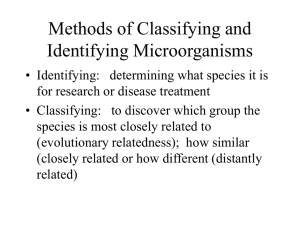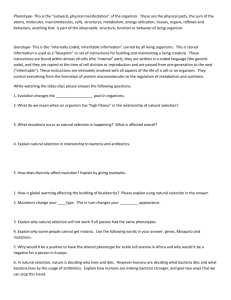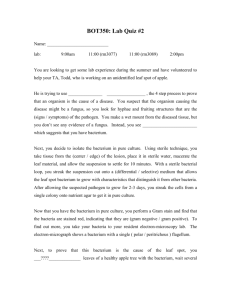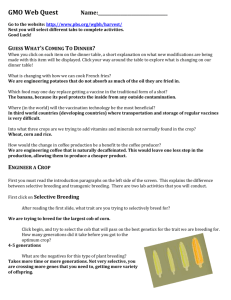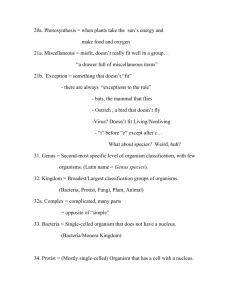Handout #5
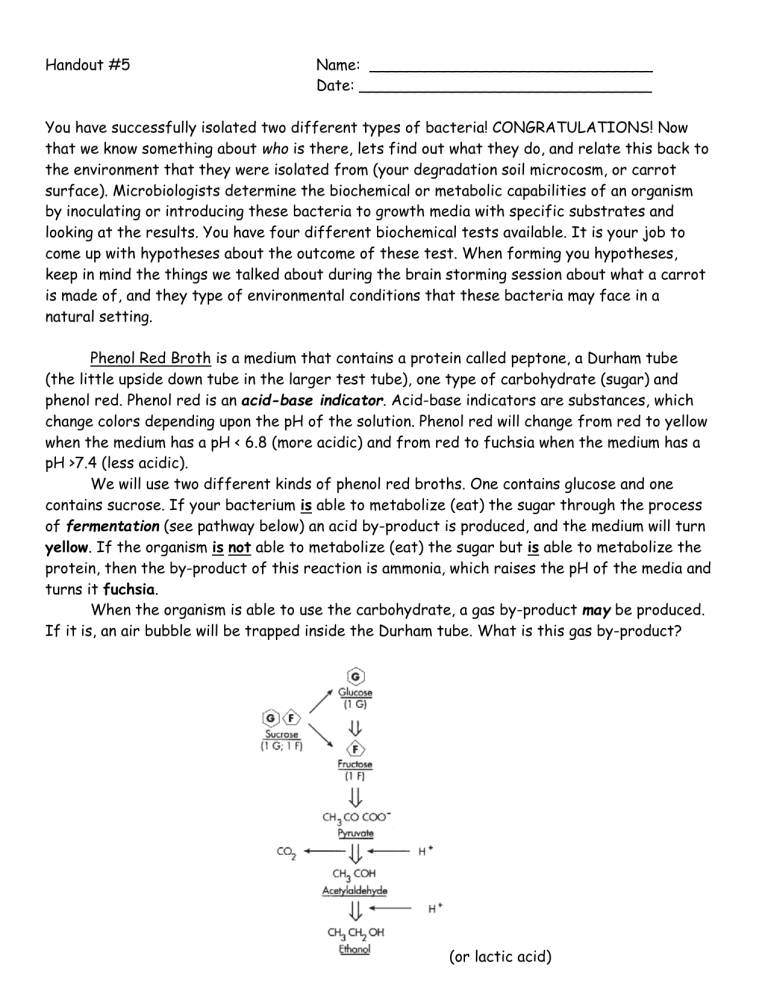
Handout #5 Name: ______________________________
Date: _______________________________
You have successfully isolated two different types of bacteria! CONGRATULATIONS! Now that we know something about who is there, lets find out what they do, and relate this back to the environment that they were isolated from (your degradation soil microcosm, or carrot surface). Microbiologists determine the biochemical or metabolic capabilities of an organism by inoculating or introducing these bacteria to growth media with specific substrates and looking at the results. You have four different biochemical tests available. It is your job to come up with hypotheses about the outcome of these test. When forming you hypotheses, keep in mind the things we talked about during the brain storming session about what a carrot is made of, and they type of environmental conditions that these bacteria may face in a natural setting.
Phenol Red Broth is a medium that contains a protein called peptone, a Durham tube
(the little upside down tube in the larger test tube), one type of carbohydrate (sugar) and phenol red. Phenol red is an acid-base indicator. Acid-base indicators are substances, which change colors depending upon the pH of the solution. Phenol red will change from red to yellow when the medium has a pH < 6.8 (more acidic) and from red to fuchsia when the medium has a pH >7.4 (less acidic).
We will use two different kinds of phenol red broths. One contains glucose and one contains sucrose. If your bacterium is able to metabolize (eat) the sugar through the process of fermentation (see pathway below) an acid by-product is produced, and the medium will turn
yellow. If the organism is not able to metabolize (eat) the sugar but is able to metabolize the protein, then the by-product of this reaction is ammonia, which raises the pH of the media and turns it fuchsia.
When the organism is able to use the carbohydrate, a gas by-product may be produced.
If it is, an air bubble will be trapped inside the Durham tube. What is this gas by-product?
(or lactic acid)
Do you think that your bacteria are able to ferment glucose or sucrose? Do you think that they will produce gas as a by-product?
GLUCOSE
H1: __________________________________________________________________
______________________________________________________________________
H2:___________________________________________________________________
______________________________________________________________________
Which hypothesis have you and your group decided on?
Bacterium 1: _______
Bacterium 2: _______
SUCROSE
H1: __________________________________________________________________
______________________________________________________________________
H2: __________________________________________________________________
______________________________________________________________________
Which hypothesis have you and your group decided on?
Bacterium 1: _______
Bacterium 2: _______
Starch agar is a medium that tests the ability of an organism to produce certain exoenzymes
(enzymes that are produced inside of the cell, and transported out of the cell to break down certain substances) that hydrolyze starch. What does hydrolyze mean? Starch molecules are
2
too big to enter the bacterial cell, so some bacteria secrete these exoenzymes to degrade or break down the starch into subunits that are SMALL and SOLUBLE that can then be used by the bacteria.
Starch agar medium has nutrients with starch added. Since no color change occurs in the medium when organisms hydrolyze starch (unlike the phenol-red broth) we add iodine to the plate after incubation. Iodine turns the plate blue, purple, or black (depending on the concentration of iodine) in the presence of starch. A clear area around the bacterial growth indicates that the organism has hydrolyzed starch.
Do you think that your bacteria are able to hydrolyze starch?
H1: __________________________________________________________________
______________________________________________________________________
H2: __________________________________________________________________
______________________________________________________________________
Which hypothesis have you and your group decided on?
Bacterium 1: _______
Bacterium 2: _______
DNase agar is a medium that tests the ability of an organism to produce an exoenzyme, called deoxyribonuclease or DNase that hydrolyzes DNA. DNase agar contains nutrients for the bacteria, DNA, and methyl green as an indicator. Methyl green is a positively charged molecule that binds to the negatively charged DNA.
Deoxyribonuclease allows the organisms that produce it to break down DNA into smaller fragments. When the DNA is broken down, it no longer binds to the methyl green, and a clear halo will appear around the areas where the DNase-producing organism has grown.
Why would the ability to break down DNA be beneficial for a soil-dwelling organism to break down DNA? ____________________________________________________________
______________________________________________________________________
Do you think that your bacteria are able to degrade DNA?
3
H1: __________________________________________________________________
______________________________________________________________________
H2: __________________________________________________________________
______________________________________________________________________
Which hypothesis have you and your group decided on?
Bacterium 1: _______
Bacterium 2: _______
4



